On our recent trip to southeast Utah my son and I visited many ruins and even more rock art panels. We saw everything from archaic anthropomorphic petroglyphs to Barrier Canyon pictographs to mud handprints to cowboy graffiti from early last century. We spent a long afternoon at the Edge of Cedars Museum in Blanding. If you visit the area make it a point to stop at the museum for at least a couple of hours. It is built adjacent to a pueblo that has been extensively excavated and reconstructed. There is even a kiva that you can enter. They have an amazing collection of artifacts including four Cottonwood plates that appear to have been made yesterday and four hafted stone knives, from the same cache, that are as well preserved as the plates. I have never seen wooden plates before, nor knives in this condition, from anywhere in the southwest.
Rock Art
Nicolai and I visited some of the more well-known panels close to Moab including Courthouse Wash panel, Moonflower panel and others along Kane Springs road, and one lesser-known panel north of town. The most impressive rock art on our trip was during our backpack on Cedar Mesa.
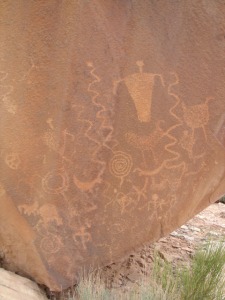
Rock art on boulder in Cedar Mesa canyon.
The panel at left was one of about 6 panels located on some very large boulders at the base of a ruin. The ruin had about 15 rooms and a number of associated granaries, with other dwellings located nearby. In all, within about a 300 meter radius, there were likely 25 or so rooms that could have been used as living quarters. There were about 10 granaries in total associated with them.
The boulder in the photo has light patination. Most of the others are much darker. The petroglyphs on the boulders and ruin walls include a few different human forms including horned anthropomorphs, kokopelli figures, and the Abajo-La Sal Style human form in this photo (see Sally Cole’s Legacy on Stone, page 159). There were also bighorn sheep, spirals and concentric circles, zigzag lines or snakes, birds- turkey and quail, mazes or maps, a staff, and atlatls. This gives a short list of the elements visible on the panels at this ruin. One could spend days or weeks exploring all the elements, their time spans, and meanings.
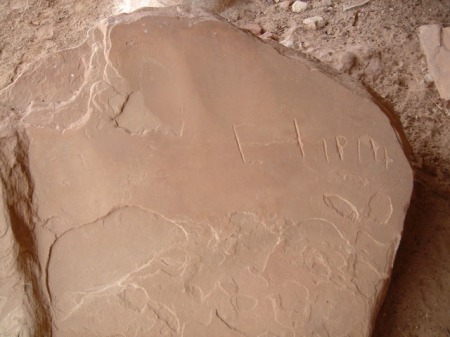
Initial and date graffiti on a rock used for grinding by the ancient inhabitants of this rock shelter.The rock shelter has the remnants of at least two granaries, as well as debris from years of use by cowboys.
Besides the petroglyphs the same location had mud handprints and initials and dates of cowboys that likely spent some time tending cattle in the canyon bottom. The photo above shows one of the initial and date sets. It reads “EH”, with a date of 1914. I gather that EH was not entirely literate based on the backwards “9”. There are two other sets at this location, one dated 1914 and the other 1940.
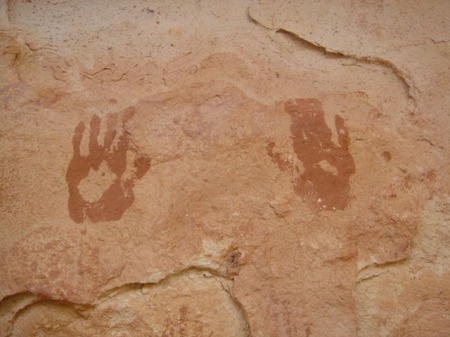
Mud hand prints in Step Canyon.
A Few Words About Ruins
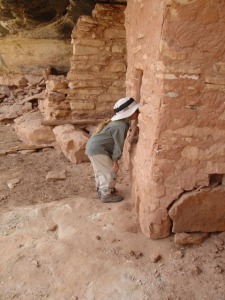
Nicolai peeks into one of the rooms.
The ruins in Grand Gulch in general are some of the best preserved that can be found. Those we visited are well-preserved for the most part, with what might be described as medium-quality masonry, having solid walls with the fingerprints of the builders still visible. Many doorways are still intact, with their pine lintels as if they were installed yesterday. I have stressed the importance of helping to preserve ruins and rock art to Nicolai since his first visit. When we visit I remind him about not climbing or leaning on, or even touching any of the ruin walls, and especially the rock art. He has already developed an appreciation for these irreplaceable cultural treasures, and an understanding of the importance of preserving the ruins, rock art, and artifacts in their original context for scientific purposes. He also understands that we are respectful of the old people and their descendants when we visit these places.
Looters
The big news during our trip came from the towns of Blanding and Monticello. On Wednesday, June 10th, the Feds arrested 24 people, mostly in Blanding and Monticello, for artifact theft. There had been an undercover operation going on there for the last couple of years. See the Salt Lake Tribune or LA Times article for the complete story. The names on the list included a teacher, David Lacy (who apparently had the same troubles in the past), James Redd, the local physician (who committed suicide the next day), and one of the more respected people in Blanding, the man in part respponsible for putting Blanding on the map- Harold Lyman. Lyman also helped protect the ruins and found the Edge of Cedars Museum. The locals were very upset, both in Blanding and Monticello, as many people in these small communities were impacted in some way by the arrests. Some are claiming that the Feds used undue force when making the arrests, the same claim that was made after the last raid of the area 15 years back or so for the same reason.
There is never a less-than exciting moment when we visit southeast Utah. I will watch as the story of the looters unfolds and include any news in future posts.
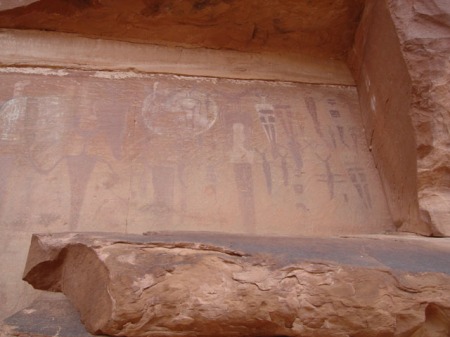
Final shot- Barrier Canyon pictographs at Courthouse Wash panel.



 Posted by desertexplorer
Posted by desertexplorer